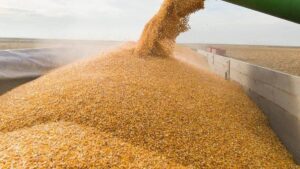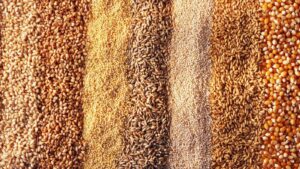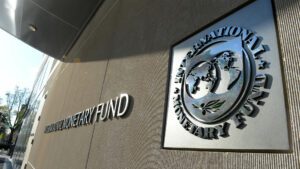
The U.S. Department of Agriculture (USDA) raised the forecast of wheat exports from Ukraine in 2023/24 marketing year by another 1.5 mln tonnes to 16.5 mln tonnes.
According to the April report of the U.S. agency, at the same time, the estimate of carry-over stocks at the end of the MY was reduced from 3.28 mln tonnes to 1.58 mln tonnes, domestic consumption – from 7.7 mln tonnes to 7.3 mln tonnes, and carry-over stocks at the beginning of the MY – from 3.5 mln tonnes to 2.9 mln tonnes.
As for Ukrainian corn, the forecast of its exports after increasing by 1.5 mln tons in March, in April was kept at the same level – 24.5 mln tons.
At the same time, the overall forecast for Ukrainian feed grains was increased by 0.1 mln tonnes to 26.97 mln tonnes due to the same reduction of carry-over stocks at the end of this MY to 4.08 mln tonnes.
In general, the updated global wheat harvest forecast for 2023/24 MY has been improved by 0.66 mln tonnes to 787.36 mln tonnes, while the forecast for global wheat exports has been increased by 1.34 mln tonnes to 213.47 mln tonnes. On the contrary, experts revised the forecast of wheat ending stocks in the world downward by 0.56 million tons to 258.27 million tons.
As for corn, the forecast for its global production in April was reduced by 2.38 million tons to 1 billion 227.86 million tons, while exports were reduced by only 0.47 million tons to 200.59 million tons. The USDA also lowered its estimate of carryover stocks by 2.35 million tons to 318.28 million tons.
As reported earlier, Ukraine attributed the improvement in grain export estimates for this marketing year to the increase in the volume of grain transportation through the new sea corridor under the control of the Ukrainian Navy.

The Ukrainian Grain Association (UZA) has updated its estimate of the potential 2023 harvest, increasing it by 7.8 million tons to 76.8 million tons of grains and oilseeds, 3 million tons more than last year.
“The increase in this year’s crop forecast is due to favorable weather conditions and better-than-expected crop yields, although the area planted is 2.2 million hectares smaller than last year,” the association said in a statement on Thursday.
According to the updated forecast, exports from Ukraine in the new season 2023/2024 could potentially reach almost 48 million tons, while last season, which ended on June 30, according to UZA estimates, it reached 58 million tons worth about $20 billion.
It is specified that the 2023 wheat crop estimate has improved from 17.9 million tons to 20.2 million tons (2022 was 20.2 million tons and 2021 was a record 33 million tons). Potential wheat exports in MY 2023/2024 could be around 15 million tons, given the early season transitional residue of 4.3 million tons.
UZA also raised its 2023 barley crop forecast to 5.2 million tons from 4.4 million tons (10.1 million tons in 2021 and 5.8 million tons in 2022) and potential exports to 2.6 million tons.
Corn crop expectations for the new season have improved from 24.2 million tons to 26.9 million tons (2021 – 37.6 million tons, 2022 – 27.3 million tons), with potential exports of about 22 million tons, the report said.
According to it, the sunflower crop estimate for 2023 is raised from 12.7 to 13.9 million tons (2021 – 16.9 million tons, 2022 – 11.1 million tons), potential exports could be 1.1 million tons, and sunflower seed processing could be 12.5 million tons.
The UZA tentatively estimates the 2023 rapeseed harvest at 3.9 million tons and exports at 3.7 million tons, while the soybean harvest is expected to be larger – the estimate has increased from 4.4 to 4.8 million tons, and its potential 2023/2024 MY exports could reach 3.3 million tons.
UZA emphasizes that in general, grain and oilseed exports in the new 2023/2024 MY can be expected at the indicated level if Ukraine is able to export through its Black Sea ports and if logistics of alternative routes, including the Danube route, improve and become cheaper.
“Further impediments to grain exports from Ukraine will have a negative impact on the availability of grain on the world market and will lead to higher prices and, consequently, increased food inflation in the world. Moreover, in case of impossibility to export products, Ukrainian farmers may reorient their production and refuse to grow grain, which will further aggravate the crisis in the world food market in the medium term,” UZA said.
The Ukrainian Grain Association (UZA) is an association of grain producers, processors and major exporters of grain, which annually export about 90 percent of Ukrainian grain products.

The Ministry of Agrarian Policy of Ukraine due to favorable weather conditions has improved the forecast of harvest in 2023 by about 4%, Minister Mykola Solskiy said on the air of the national telethon.
“We have adjusted our forecast of this year’s harvest compared to last year’s … by 10% down. But the weather is really this year, according to the state as of today, ufu-tufu-tufu, so that it would continue to be so, it is good enough, let’s say, cautiously. And we have already adjusted this forecast for the better: we think that the drop will be by +/- 6 percent compared to last year. This is preliminary, because there are still a few months ahead,” said the Minister.
He specified that the initial forecast was based on the change in the structure of sown areas caused by logistical problems in favor of more expensive crops, but with lower yields (for example, soybeans or sunflowers instead of corn), as well as less investment in land.
Solsky specified that canola, barley and wheat have been harvested for several weeks now.
“Rapeseed (will be) like last year, maybe even a little more. Barley – less, because less was planted, by 15-20 percent. And there will be less wheat because less was planted. We hope to compensate with spring crops in the fall, but let’s not guess,” – said the Minister.
As reported, First Deputy Minister of Agrarian Policy and Food Taras Vysotskyy at the end of June predicted grain harvest this year at the level of about 46 million tons compared to 53.1 million tons in the previous season.
At the same time, Ukrhydrometeocenter in early July gave a more optimistic estimate – about 49.6 million tons.

The forecasted gross harvest of grain crops in Ukraine in 2023 could be 34 million tons, which is 37% less than in 2022 and 60% less than in 2021, while the yield of oilseeds is expected to be 19.3 million tons, which is 13% more than in 2022 and 15% less than in 2021.
As reported on the website of the Ukrainian Agribusiness Club Association (UCAB) on Friday, such a reduction in the grain harvest is caused by the reduction of cultivated areas under crops next year by 45%, to 8.7 million hectares.
The reasons for the reduction in the grain harvest next year will be a decrease in the total sown area, a change in the structure of crops in favor of oilseeds and lower yields of grain crops.
UCAB noted that of the 28.4 million hectares under cultivation in 2021, by December 2022 there are 24.6 million hectares of agricultural land (86% of the total area) in the controlled territory of Ukraine, of which 3.8 million hectares are not suitable for agricultural work due to their proximity to the front lines, contamination by mines and shells, etc. In addition, the end of the sowing campaign of winter crops has demonstrated a significant reduction in the sown area – 3.8 million hectares of winter crops have been sown in 2022, which is 43% lower than in 2021.
UCAB stressed that the reason for this trend is the limited ability to export crops, expensive logistics and, as a consequence, a significant difference in prices of crops by region.
“The regions that are geographically close to sea ports and borders with the EU, have a higher price for agricultural products compared to the regions in the north and east of our country. For example, the price of corn with VAT in Transcarpathian region is 6800 UAH per ton, and in Sumy region – 4900 UAH. However, even in western regions the price is unprofitable. Therefore, the proximity of the border with the EU and working ports determines the ability of the relevant areas to continue grain production, “- the association specified in the message.
In turn, next 2023 will see an increase in the area under oilseeds due to their higher margins compared to grain crops and a significant increase in the logistics of grain this year.
“The price of oil-bearing crops is 2 times higher than the price of grain crops on the world market. According to preliminary estimates, the sown areas under grain crops in 2023 will be 8.7 million hectares, which is 22% less than in 2022 and 45% less than in 2021. The projected area sown with oilseeds is 9.7 million hectares, which is 32% more than in 2022 and 9% more than in 2021. For the first time, the area under oilseeds will be larger than that under grains,” the UCAB said in a statement.
In addition, next year’s average yield will decrease by 10-30%, depending on the region and crop, compared to the average yield of previous years due to a 50-60% reduction in fertilizer application, significant amounts of corn left in the fields of the 2022 crop, the lack of agribusiness funding and the need for significant resource savings.
UCAB stressed that taking into account the given gross production volumes and domestic needs of Ukraine the export potential of grains and oilseeds in 2023/24 marketing year (MY, July-June) will be about 35 million tons, or 3 million tons per month. For comparison, in 2021/22 MY export potential was at the level of 85 million tons of grains and oilseeds, or 7 million tons per month.
As reported, Ukraine in 2021 harvested a record crop of cereals, legumes and oilseeds at 106 million tons: 84 million tons of cereals and legumes, and 22.6 million tons of oilseeds.
A total of 32.4 million tons of wheat, 40 million tons of corn, 10 million tons of barley, 581.5 thousand tons of peas, 191 thousand tons of millet and 110 tons of buckwheat were harvested last year. Sunflower harvest amounted to 16.3 million tons, soybeans – 3.4 million tons and rapeseed – 2.9 million tons.
2022-2024 goods trade balance forecast (USD billion)

NBU

The International Monetary Fund (IMF) left unchanged its July forecast for global economic growth in 2022 – 3.2% (in January, an increase of 4.4% was expected, in April – by 3.6%). For 2023, the estimate is lowered to 2.7% from 2.9% in July and 3.6% in April (in January, the IMF predicted global GDP growth of 3.8%).
“The global economy continues to face serious challenges caused by the lingering impact of three powerful forces: the Russian invasion of Ukraine, the “cost of living crisis” caused by persistent and increasing inflationary pressures, and the slowdown in China. (…) GDP of countries representing more than a third of the world economy will contract in 2023, while the three largest economies – the US, the European Union and China – will continue to slip. In short, the worst is yet to come, and for many, 2023 will feel like a recession,” the report says.
Russia’s war against Ukraine has triggered an energy crisis in Europe that is drastically increasing the cost of living and hindering economic activity, the IMF writes. “Gas prices in Europe have more than quadrupled since 2021, with Russia cutting deliveries to less than 20% of 2021 levels, raising the possibility of power shortages next winter and beyond. More broadly, the war has also pushed up food prices on world markets, despite the recent decline in prices following the Black Sea grain deal, which has caused severe hardship for low-income families around the world, especially in low-income countries.
The report also notes that sustained and rising inflationary pressures have caused a rapid and synchronized tightening of monetary conditions, along with strong dollar appreciation against most other currencies. “Tighter global monetary and financial conditions will affect the economy, reducing demand and helping to gradually curb inflation. However, so far, price pressures remain quite persistent and are of great concern to policymakers. We expect global inflation to peak at the end of 2022, but will remain high for longer than previously expected, falling to 4.1% by 2024.
COUNTRY ASSESSMENTS
The IMF insignificantly, but still improved its forecast for the growth of the economies of emerging markets and developing countries for 2022 – to 3.7% from 3.6% (in April it expected 3.8%), for 2023 – lowered to 3. 7% from 3.9% (April – 4.4%).
The growth forecast for the Chinese economy this year has been worsened to 3.2% from 3.3% (in April, an increase of 4.4% was expected, in January – by 4.8%), in 2023 – to 4.4% from 4 .6% (April estimate – 5.1%).
India’s GDP growth estimate has also been reduced to 6.8% from 7.4% (April – 8.2%) in 2022, and remained unchanged for 2023 – 6.1% (April – 6.9%).
At the same time, the growth forecast for the Brazilian economy has been significantly increased for 2022 – up to 2.8% from 1.7% in July and 0.8% in April, for 2023 it has also been increased – up to 1% from up to 0.9% (April forecast – 1.4%).
The estimate of GDP growth in developed countries in 2022 is worsened by 0.1 percentage points – up to 2.4% (April – 3.5%) and by 0.3 percentage points. – up to 1.1% – in 2023 (2.4% – April estimate).
The IMF continued to reduce the forecast for US GDP growth in 2022 – by 0.7 percentage points. to 1.6% (April – 3.7%). The following year, the estimate remained the same – 1% (April – 2.3%).
The economy of the eurozone countries this year, according to the IMF, will grow by 3.1%, the forecast has been improved from 2.6% in July and 2.8% in April). For 2023, the estimate is downgraded by 0.7 p.p. – up to 0.5% (April – 2.3%).
Italy’s 2022 GDP growth forecast has been raised to 3.2% from 3% in July and 2.3% in April. In 2023, the IMF expects the economy to decline by 0.2%, in July it predicted an increase of 0.7%, in April – by 1.7%.
The German economy in 2022 will grow, according to the IMF, only by 1.5% (better than the July forecast – 1.2%). At the same time, in 2023, the economy is expected to decline by 0.3% (in July, an increase of 0.8% was expected, in April – by 2.7%).
The forecast for Spain for the current year has been raised to 4.3% from 4% (in April – 4.8%) and lowered to 1.2% from 2% in 2023.
For France, the estimate for the current year has been improved to 2.5% from 2.3% and by 0.4 percentage points, for 2023 it has been worsened to 0.7% from 1%.
The growth forecast for the UK economy for 2022 has been improved to 3.6% from 3.2%, for 2023 it has been worsened to 0.3% from 0.5%. Japan’s GDP growth estimate for the current year remained at the level of 1.7%, for 2023 it decreased to 1.6% from 1.7%.